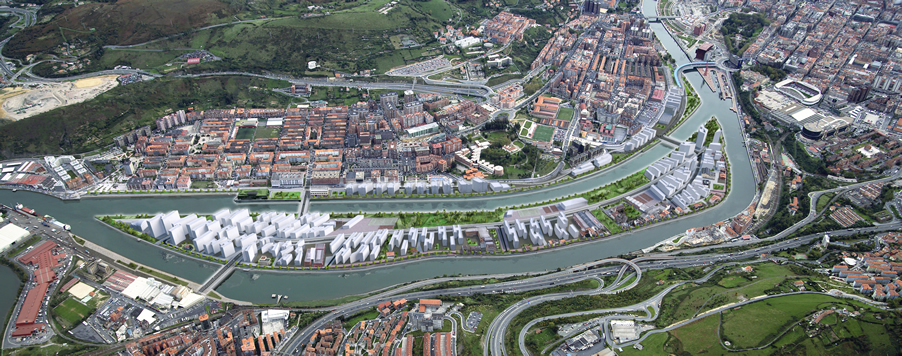PLANNING
Special Urban Plan for Zorrotzaurre
See the complete documentation of the SPECIAL URBAN PLAN FOR ZORROTZAURRE
On November 29th 2012, the Bilbao City Council gave definitive approval to the SpecialUrban Plan for Zorrotzaurre.
Initially approved on November 9th 2011, the Plan has had two periods of public exposition. The first period ran from November 29th 2011 until January 26th 2012, when 38 allegations were received. The second period ran from June 9th 2012 to July 2nd 2012 when 10 allegations were received.
As a result of the allegations, a number of modifications were introduced into the initial planning approach, some of a minor nature and others more fundamental, the most important of which were:
– Maintenance of the former industrial building known as the ‘Papelera’, which is located on the Deusto riverbank and which will become a cultural centre.
– The elimination of the district heating unit, leaving its site in San Ignacio free for other public uses.
The definitive Special Plan
The Special Plan for Zorrotzaurre is based on the Master Plan designed by the prestigious Iraqui-British architect ZahaHadid, (Pritzker Prize 2004) to which a number of ideas from neighbours, associations and political parties have been added over time.
Thus, an area of nearly 84 hectares, divided between the 609,110m2 of the future Zorrotzaurre (Mixed Zone) and the 213,441m2 of the Deusto Canal and the Idom and IMQ sites has been designed as a place to live, work and enjoy life.
The opening of the canal will create an island
The main element of the plan is to transform Zorrotzaurre into an island. Starting from that point, the whole project tries to develop the character of being an island from many different points of view: the new opened-up Deusto canal, the watersides converted into pathways, the uses of the canal-side land (green zones, educational, sports and cultural uses) as well as the layout of the housing in strips, perpendicular to the river and the canal, to ensure that everywhere has a sight of water.
The opening of the canal, the works of which have already begun, was decided on due to the different hydraulic studies that confirmed the need to open the canal to minimize the risk of flooding in Bilbao. The positive effects of the opening up of the canal will reach back up river as far as the Old Quarter of Bilbao.
The new Zorrotzaurre
Two thirds of the new Zorrotzaurre (the Mixed Zone) will have public uses, including 154,066,2 of open areas and 93,537m2 in land for public installations for educational, health, sport and cultural uses.
The future Zorrotzaurre will have a mixture of uses (housing, offices, shopping and other public and private installations), which will favour balanced urban development and reduce mobility requirements. In order to achieve an adequate mix of uses, economic activity will represent 25% of what is to be built.
The Plan supposes the construction of 5,473 dwellings (half publicly promoted and subsidized and half privately promoted) and 202,129m2 of construction for economic activity, which will allow Zorrotzaurre to support around 6,000 jobs.
The areas of San Ignacio and Deusto will reach down to the canal and be open to the water and will have a 20 metre wide riverside walk to connect to the BoticaViejapark.
There will be two self-sufficient residential areas, one at each end of the island. Each will house a mix of activities: housing, shops, offices, public buildings, leisure, etc.)
Between these areas around the San Pablo church, where the majority of current housing is located, a special ‘old quarter’ will be created where the current character of the area will be preserved.
Urban structure
The road network is simple, based on a central avenue with wide pavements and a cycle path, which will also carry the tram, which will serve the island through four stops. At each end of the island, a simple road layout will allow easy access to and exit from the island.
Three bridges will be built to connect the island to the surrounding areas: one to Deusto, another to San Ignacio and a third bridge to Zorrotza which will open to guarantee navigability as far as the Maritime Museum. There will also be a fourth bridge to allow the tram access to the island from the Ensanche.
Economic activity will be concentrated in the urban technology park, which will be located at each end of the island close to the bridges for easy access.
19 former industrial buildings located throughout the island will be conserved for new uses after their renovation.



